A Global Proteomic Approach Sheds New Light on Potential Iron-Sulfur Client Proteins of the Chloroplastic Maturation Factor NFU3
Abstract
:1. Introduction
2. Results
2.1. Expression Analysis and Protein Localization of NFU1, NFU2, and NFU3
2.2. Global Analysis of the Biological Function of Proteins Whose Abundance is Affected in nfu3-2 Mutant
2.3. The Biological Function of Proteins Whose Abundance is Affected in nfu3-2 and nfu2-1 Does Not Fully Overlap
2.4. Quantification of Chloroplastic Fe-S Proteins in the nfu3-2 Mutant
3. Discussion
3.1. Plastidial NFUs Display Overlapping Patterns of Expression
3.2. Proteomic Adjustments in the nfu3 Mutant Suggest both Common and Specific Metabolic and Physiological Adjustments with nfu2
3.3. Variations in Fe-S Proteins
4. Materials and Methods
4.1. Plant Material and Growth Conditions
4.2. Cloning
4.3. Histochemical GUS Detection and GFP Confocal Observation
4.4. Gene Expression Analysis
4.5. Liquid Chromatography Coupled with Mass Spectrometry (LC-MS/MS) Analysis
Supplementary Materials
Author Contributions
Funding
Acknowledgments
Conflicts of Interest
References
- Balk, J.; Pilon, M. Ancient and essential: The assembly of iron-sulfur clusters in plants. Trends Plant Sci. 2011, 16, 218–226. [Google Scholar] [CrossRef] [PubMed]
- Balk, J.; Schaedler, T.A. Iron cofactor assembly in plants. Annu. Rev. Plant Biol. 2014, 65, 125–153. [Google Scholar] [CrossRef] [PubMed]
- Couturier, J.; Touraine, B.; Briat, J.F.; Gaymard, F.; Rouhier, N. The iron-sulfur cluster assembly machineries in plants: Current knowledge and open questions. Front. Plant Sci. 2013, 4, 259. [Google Scholar] [CrossRef] [PubMed] [Green Version]
- Pilon, M.; Abdel-Ghany, S.E.; Van Hoewyk, D.; Ye, H.; Pilon-Smits, E.A. Biogenesis of iron-sulfur cluster proteins in plastids. Genet. Eng. 2006, 27, 101–117. [Google Scholar]
- Przybyla-Toscano, J.; Roland, M.; Gaymard, F.; Couturier, J.; Rouhier, N. Roles and maturation of iron-sulfur proteins in plastids. J. Biol. Inorg. Chem. 2018, 23, 545–566. [Google Scholar] [CrossRef] [Green Version]
- Bandyopadhyay, S.; Gama, F.; Molina-Navarro, M.M.; Gualberto, J.M.; Claxton, R.; Naik, S.G.; Huynh, B.H.; Herrero, E.; Jacquot, J.P.; Johnson, M.K.; et al. Chloroplast monothiol glutaredoxins as scaffold proteins for the assembly and delivery of [2Fe-2S] clusters. EMBO J. 2008, 27, 1122–1133. [Google Scholar] [CrossRef] [Green Version]
- Abdel-Ghany, S.E.; Ye, H.; Garifullina, G.F.; Zhang, L.; Pilon-Smits, E.A.; Pilon, M. Iron-sulfur cluster biogenesis in chloroplasts. Involvement of the scaffold protein CpIscA. Plant Physiol. 2005, 138, 161–172. [Google Scholar] [CrossRef] [Green Version]
- Mapolelo, D.T.; Zhang, B.; Randeniya, S.; Albetel, A.N.; Li, H.; Couturier, J.; Outten, C.E.; Rouhier, N.; Johnson, M.K. Monothiol glutaredoxins and A-type proteins: Partners in Fe-S cluster trafficking. Dalton Trans. 2013, 42, 3107–3115. [Google Scholar] [CrossRef] [Green Version]
- Banci, L.; Brancaccio, D.; Ciofi-Baffoni, S.; Del Conte, R.; Gadepalli, R.; Mikolajczyk, M.; Neri, S.; Piccioli, M.; Winkelmann, J. [2Fe-2S] cluster transfer in iron-sulfur protein biogenesis. Proc. Natl. Acad. Sci. USA 2014, 111, 6203–6208. [Google Scholar] [CrossRef] [Green Version]
- Brancaccio, D.; Gallo, A.; Mikolajczyk, M.; Zovo, K.; Palumaa, P.; Novellino, E.; Piccioli, M.; Ciofi-Baffoni, S.; Banci, L. Formation of [4Fe-4S] clusters in the mitochondrial iron-sulfur cluster assembly machinery. J. Am. Chem. Soc. 2014, 136, 16240–16250. [Google Scholar] [CrossRef]
- Roland, M.; Przybyla-Toscano, J.; Vignols, F.; Berger, N.; Azam, T.; Christ, L.; Santoni, V.; Wu, H.C.; Dhalleine, T.; Johnson, M.K.; et al. The plastidial Arabidopsis thaliana NFU1 protein binds and delivers [4Fe-4S] clusters to specific client proteins. J. Biol. Chem. 2020, 295, 1727–1742. [Google Scholar] [CrossRef] [PubMed]
- Gao, H.; Subramanian, S.; Couturier, J.; Naik, S.G.; Kim, S.K.; Leustek, T.; Knaff, D.B.; Wu, H.C.; Vignols, F.; Huynh, B.H.; et al. Arabidopsis thaliana Nfu2 accommodates [2Fe-2S] or [4Fe-4S] clusters and is competent for in vitro maturation of chloroplast [2Fe-2S] and [4Fe-4S] cluster-containing proteins. Biochemistry 2013, 52, 6633–6645. [Google Scholar] [CrossRef] [PubMed] [Green Version]
- Gao, H.; Azam, T.; Randeniya, S.; Couturier, J.; Rouhier, N.; Johnson, M.K. Function and maturation of the Fe-S center in dihydroxyacid dehydratase from Arabidopsis. J. Biol. Chem. 2018, 293, 4422–4433. [Google Scholar] [CrossRef] [Green Version]
- Rey, P.; Becuwe, N.; Tourrette, S.; Rouhier, N. Involvement of Arabidopsis glutaredoxin S14 in the maintenance of chlorophyll content. Plant Cell Environ. 2017, 40, 2319–2332. [Google Scholar] [CrossRef]
- Touraine, B.; Vignols, F.; Przybyla-Toscano, J.; Ischebeck, T.; Dhalleine, T.; Wu, H.C.; Magno, C.; Berger, N.; Couturier, J.; Dubos, C.; et al. Iron-sulfur protein NFU2 is required for branched-chain amino acid synthesis in Arabidopsis roots. J. Exp. Bot. 2019, 70, 1875–1889. [Google Scholar] [CrossRef] [PubMed]
- Yabe, T.; Nakai, M. Arabidopsis AtIscA-I is affected by deficiency of Fe-S cluster biosynthetic scaffold AtCnfU-V. Biochem. Biophys. Res. Commun. 2006, 340, 1047–1052. [Google Scholar] [CrossRef]
- Lezhneva, L.; Meurer, J. The nuclear factor HCF145 affects chloroplast psaA-psaB-rps14 transcript abundance in Arabidopsis thaliana. Plant J. 2004, 38, 740–753. [Google Scholar] [CrossRef] [PubMed]
- Stockel, J.; Oelmuller, R. A novel protein for photosystem I biogenesis. J. Biol. Chem. 2004, 279, 10243–10251. [Google Scholar] [CrossRef] [Green Version]
- Nath, K.; Wessendorf, R.L.; Lu, Y. A Nitrogen-Fixing Subunit Essential for Accumulating 4Fe-4S-Containing Photosystem I Core Proteins. Plant Physiol. 2016, 172, 2459–2470. [Google Scholar] [CrossRef] [Green Version]
- Nath, K.; O’Donnell, J.P.; Lu, Y. Chloroplastic iron-sulfur scaffold protein NFU3 is essential to overall plant fitness. Plant Signal Behav. 2017, 12, e1282023. [Google Scholar] [CrossRef] [Green Version]
- Berger, N.; Vignols, F.; Przybyla-Toscano, J.; Roland, M.; Rofidal, V.; Touraine, B.; Zienkiewicz, K.; Couturier, J.; Feussner, I.; Santoni, V.; et al. Identification of client iron-sulfur proteins of the chloroplastic NFU2 transfer protein in Arabidopsis thaliana. J. Exp. Bot. 2020, 71, 4171–4187. [Google Scholar] [CrossRef] [PubMed]
- Yabe, T.; Morimoto, K.; Kikuchi, S.; Nishio, K.; Terashima, I.; Nakai, M. The Arabidopsis chloroplastic NifU-like protein CnfU, which can act as an iron-sulfur cluster scaffold protein, is required for biogenesis of ferredoxin and photosystem I. Plant Cell 2004, 16, 993–1007. [Google Scholar] [CrossRef] [PubMed] [Green Version]
- Hooper, C.M.; Castleden, I.R.; Tanz, S.K.; Aryamanesh, N.; Millar, A.H. SUBA4: The interactive data analysis centre for Arabidopsis subcellular protein locations. Nucleic Acids Res. 2017, 45, D1064–D1074. [Google Scholar] [CrossRef] [PubMed] [Green Version]
- Martin, J.L.; McMillan, F.M. SAM (dependent) I AM: The S-adenosylmethionine-dependent methyltransferase fold. Curr. Opin. Struct. Biol. 2002, 12, 783–793. [Google Scholar] [CrossRef]
- Melo-Oliveira, R.; Oliveira, I.C.; Coruzzi, G.M. Arabidopsis mutant analysis and gene regulation define a nonredundant role for glutamate dehydrogenase in nitrogen assimilation. Proc. Natl. Acad. Sci. USA 1996, 93, 4718–4723. [Google Scholar] [CrossRef] [Green Version]
- Dubois, F.; Tercé Laforgue, T.; Gonzalez Moro, M.; Estavillo, M.; Sangwan, R.; Gallais, A.; Hirel, B. Glutamate dehydrogenase in plants: Is there a new story for an old enzyme? Plant Physiol. Biochem. 2003, 41, 565–576. [Google Scholar] [CrossRef]
- Araujo, W.L.; Ishizaki, K.; Nunes-Nesi, A.; Larson, T.R.; Tohge, T.; Krahnert, I.; Witt, S.; Obata, T.; Schauer, N.; Graham, I.A.; et al. Identification of the 2-hydroxyglutarate and isovaleryl-CoA dehydrogenases as alternative electron donors linking lysine catabolism to the electron transport chain of Arabidopsis mitochondria. Plant Cell 2010, 22, 1549–1563. [Google Scholar] [CrossRef] [Green Version]
- Kluge, C.; Lahr, J.; Hanitzsch, M.; Bolte, S.; Golldack, D.; Dietz, K.J. New insight into the structure and regulation of the plant vacuolar H+-ATPase. J. Bioenerg. Biomembr. 2003, 35, 377–388. [Google Scholar] [CrossRef]
- Motohashi, R.; Rodiger, A.; Agne, B.; Baerenfaller, K.; Baginsky, S. Common and specific protein accumulation patterns in different albino/pale-green mutants reveals regulon organization at the proteome level. Plant Physiol. 2012, 160, 2189–2201. [Google Scholar] [CrossRef] [Green Version]
- Bernard, A.; Joubes, J. Arabidopsis cuticular waxes: Advances in synthesis, export and regulation. Prog. Lipid Res. 2013, 52, 110–129. [Google Scholar] [CrossRef]
- Hildebrandt, T.M.; Nunes Nesi, A.; Araujo, W.L.; Braun, H.P. Amino Acid Catabolism in Plants. Mol. Plant 2015, 8, 1563–1579. [Google Scholar] [CrossRef] [PubMed] [Green Version]
- Godman, J.; Balk, J. Genome analysis of Chlamydomonas reinhardtii reveals the existence of multiple, compartmentalized iron-sulfur protein assembly machineries of different evolutionary origins. Genetics 2008, 179, 59–68. [Google Scholar] [CrossRef] [Green Version]
- Nakagawa, T.; Suzuki, T.; Murata, S.; Nakamura, S.; Hino, T.; Maeo, K.; Tabata, R.; Kawai, T.; Tanaka, K.; Niwa, Y.; et al. Improved Gateway binary vectors: High-performance vectors for creation of fusion constructs in transgenic analysis of plants. Biosci. Biotechnol. Biochem. 2007, 71, 2095–2100. [Google Scholar] [CrossRef] [PubMed] [Green Version]
- Gao, F.; Robe, K.; Bettembourg, M.; Navarro, N.; Rofidal, V.; Santoni, V.; Gaymard, F.; Vignols, F.; Roschzttardtz, H.; Izquierdo, E.; et al. The Transcription Factor bHLH121 Interacts with bHLH105 (ILR3) and Its Closest Homologs to Regulate Iron Homeostasis in Arabidopsis. Plant Cell 2020, 32, 508–524. [Google Scholar] [CrossRef] [PubMed]
- Tissot, N.; Robe, K.; Gao, F.; Grant-Grant, S.; Boucherez, J.; Bellegarde, F.; Maghiaoui, A.; Marcelin, R.; Izquierdo, E.; Benhamed, M.; et al. Transcriptional integration of the responses to iron availability in Arabidopsis by the bHLH factor ILR3. New Phytol. 2019, 223, 1433–1446. [Google Scholar] [CrossRef]
- Czechowski, T.; Stitt, M.; Altmann, T.; Udvardi, M.K.; Scheible, W.R. Genome-wide identification and testing of superior reference genes for transcript normalization in Arabidopsis. Plant Physiol. 2005, 139, 5–17. [Google Scholar] [CrossRef] [PubMed] [Green Version]
- Cox, J.; Mann, M. MaxQuant enables high peptide identification rates, individualized p.p.b.-range mass accuracies and proteome-wide protein quantification. Nat. Biotechnol. 2008, 26, 1367–1372. [Google Scholar] [CrossRef] [PubMed]
- Cox, J.; Neuhauser, N.; Michalski, A.; Scheltema, R.A.; Olsen, J.V.; Mann, M. Andromeda: A peptide search engine integrated into the MaxQuant environment. J. Proteome Res. 2011, 10, 1794–1805. [Google Scholar] [CrossRef] [PubMed]
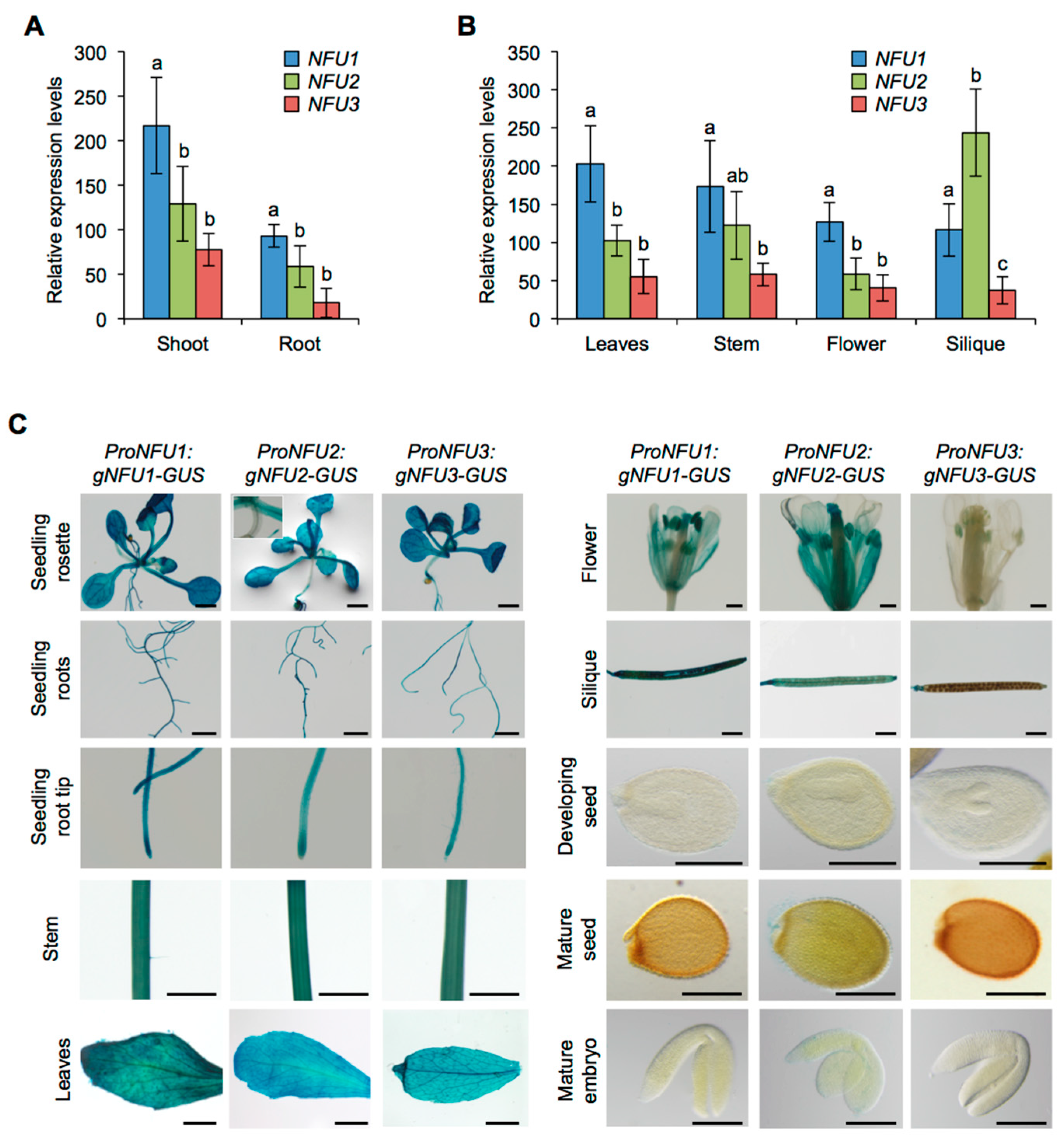
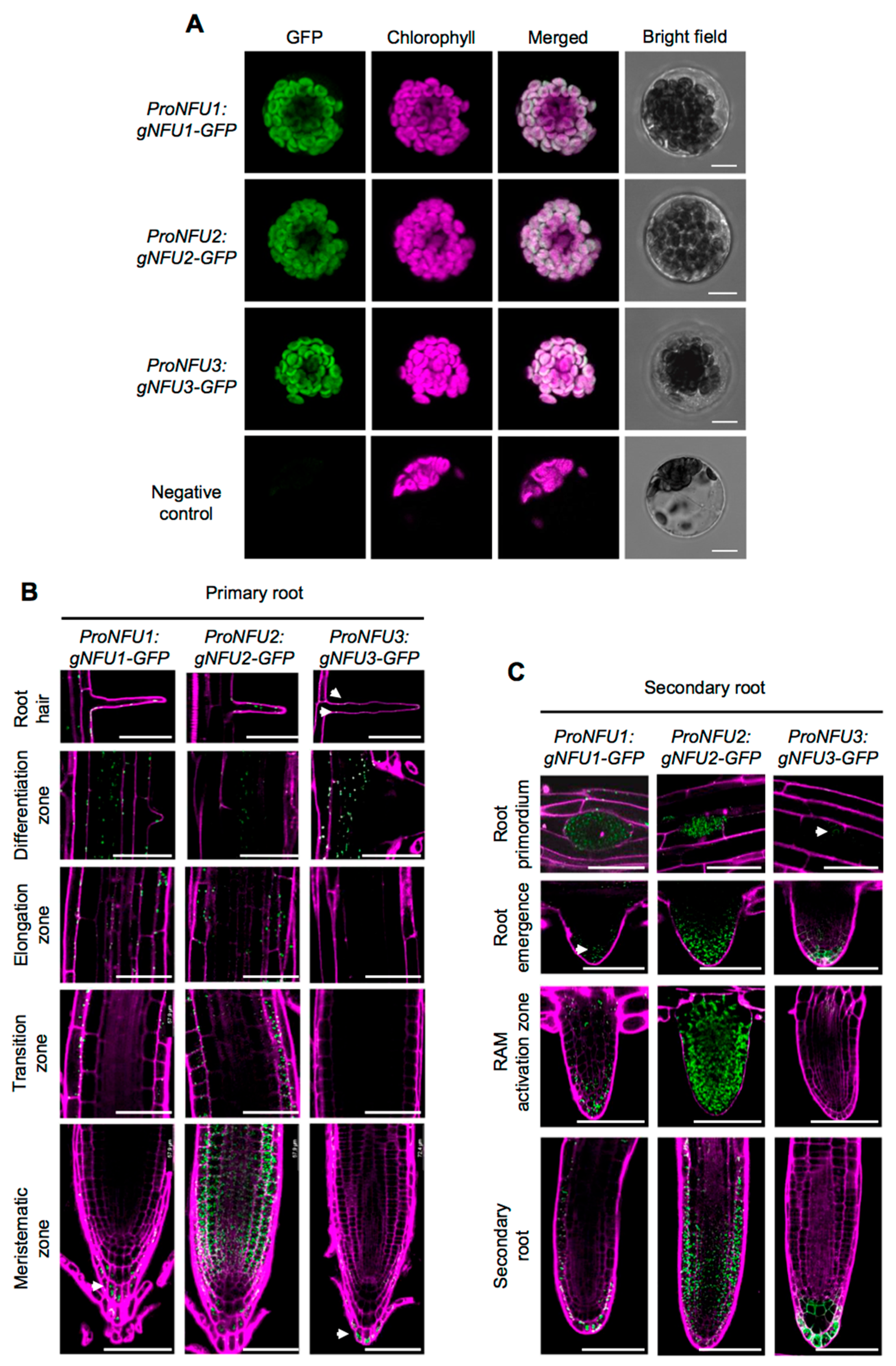
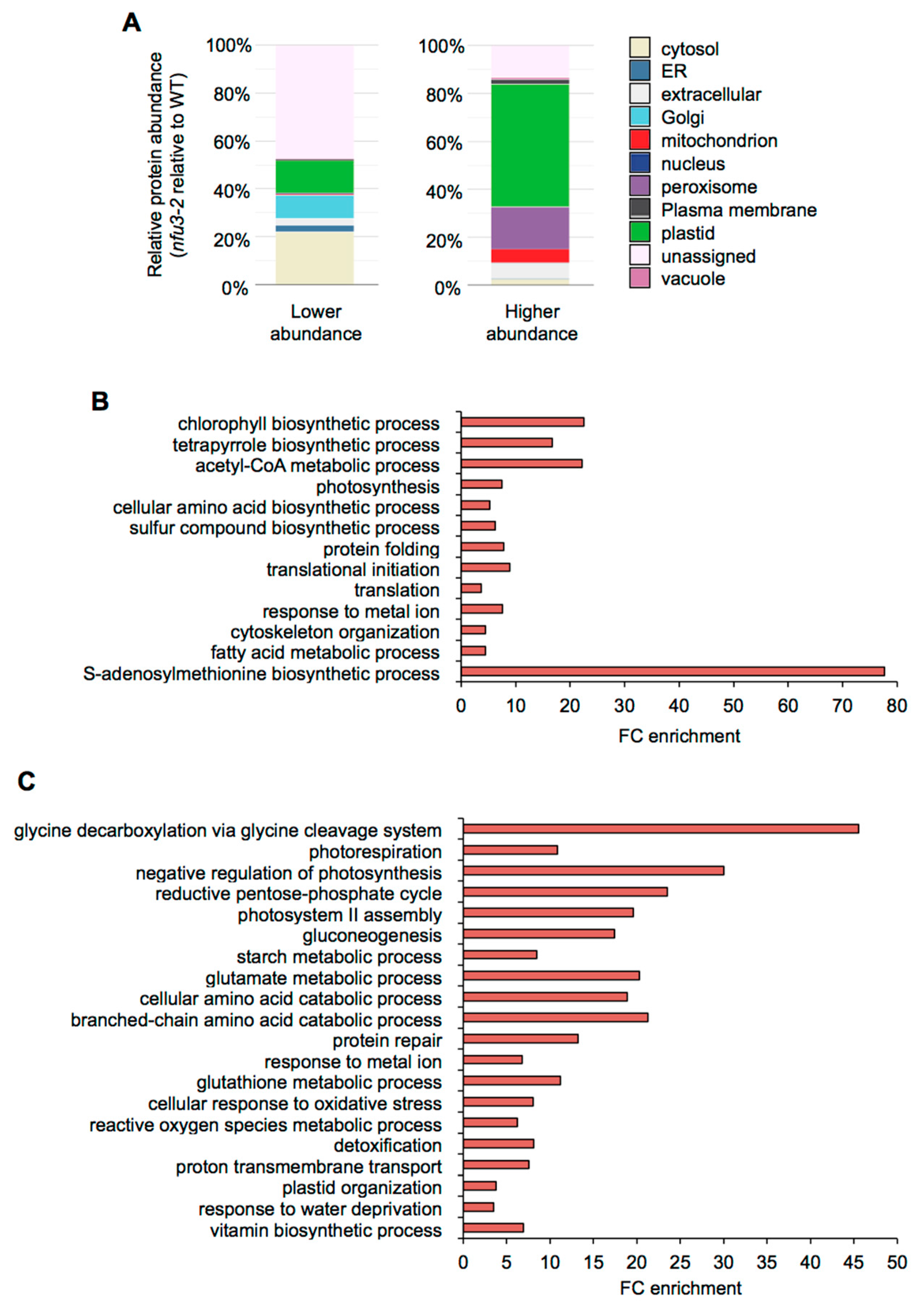
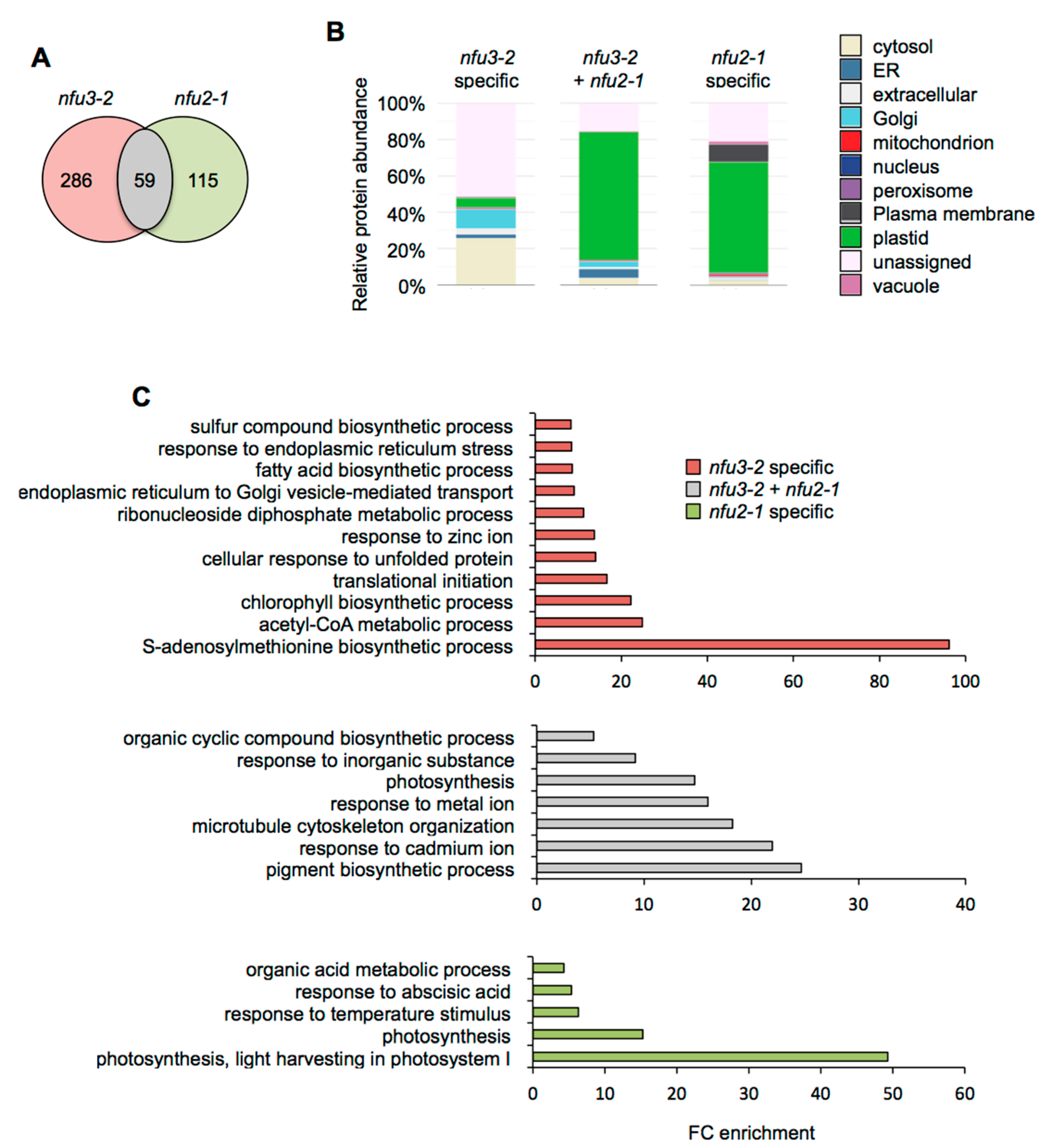
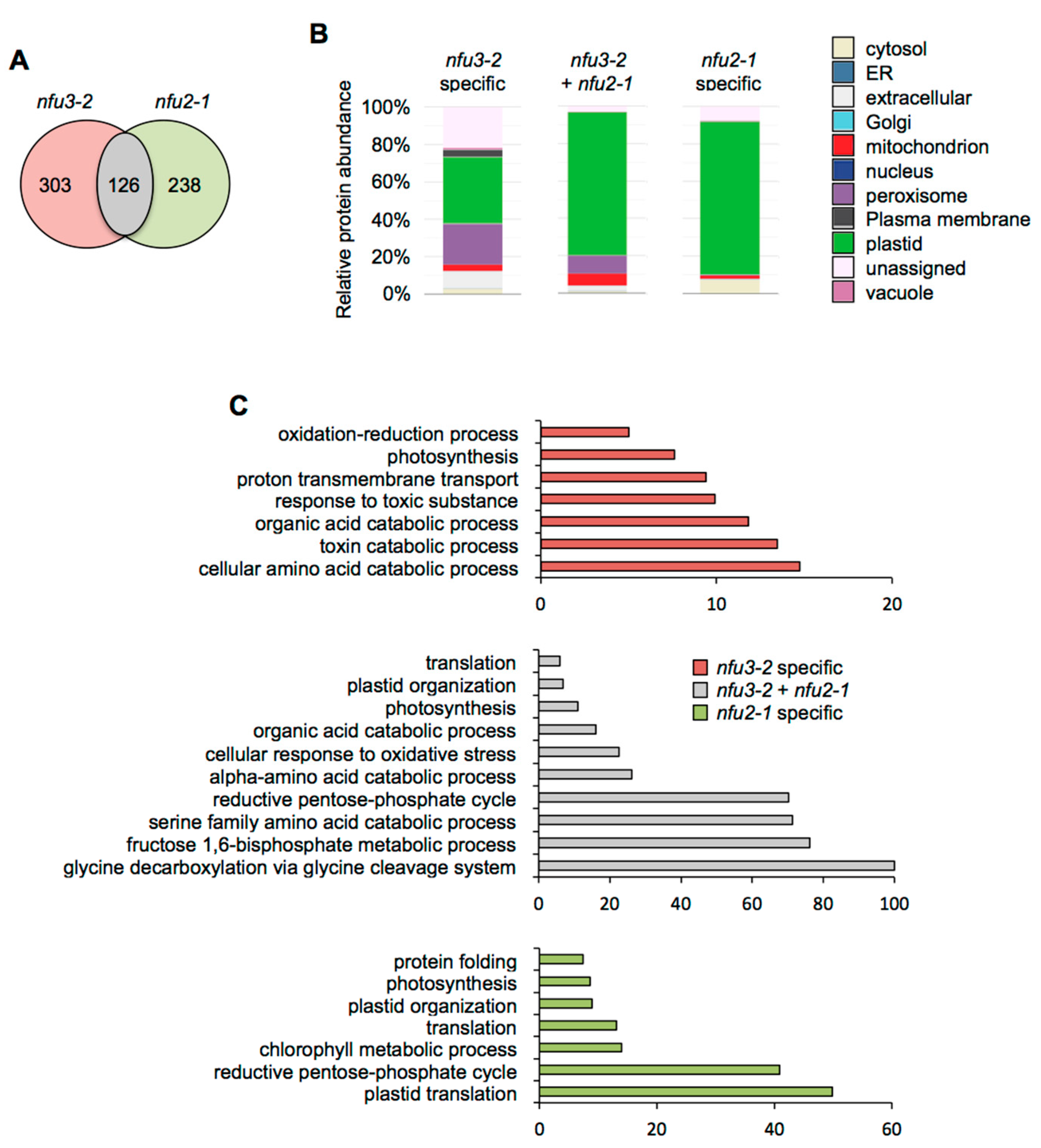
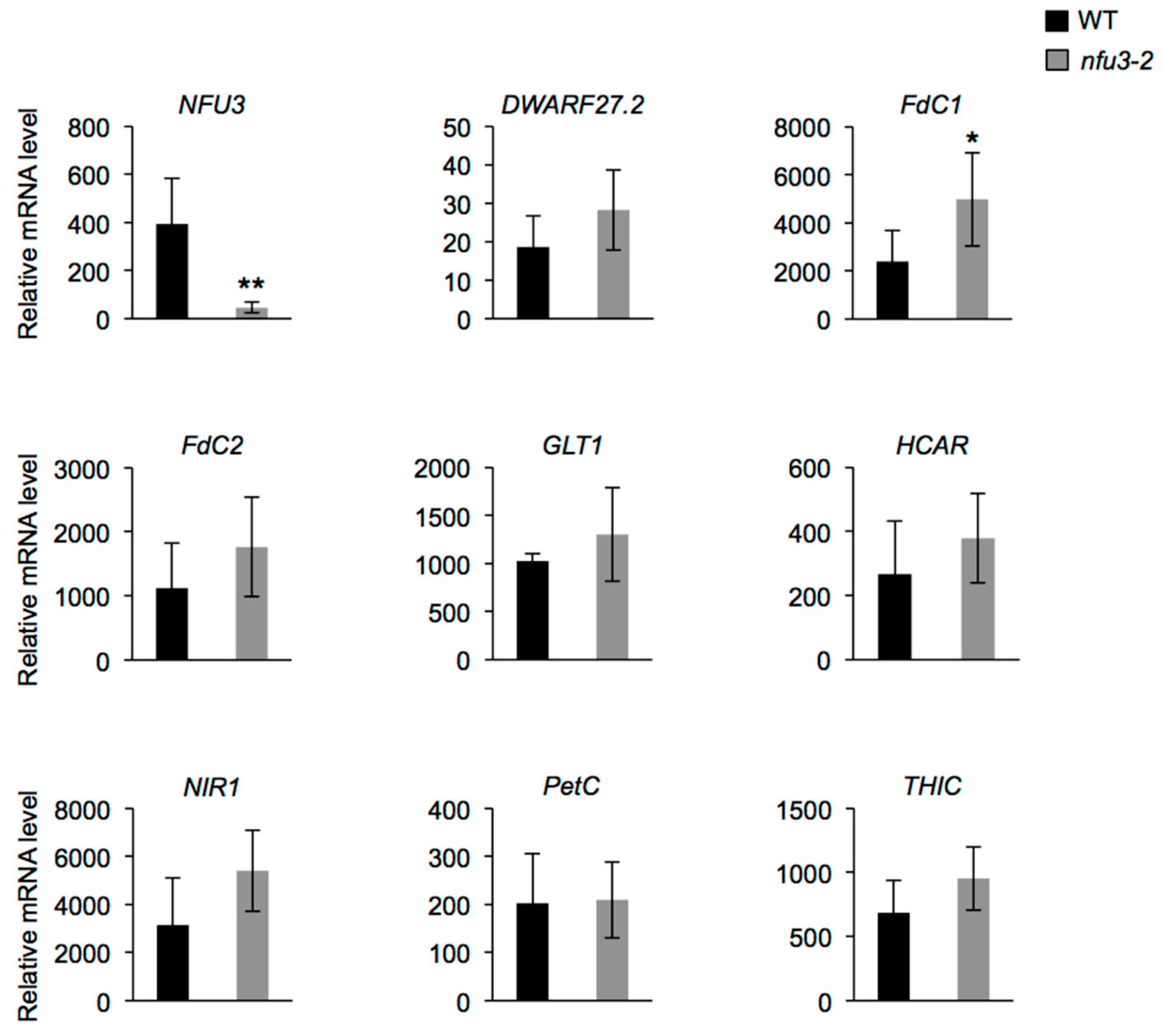
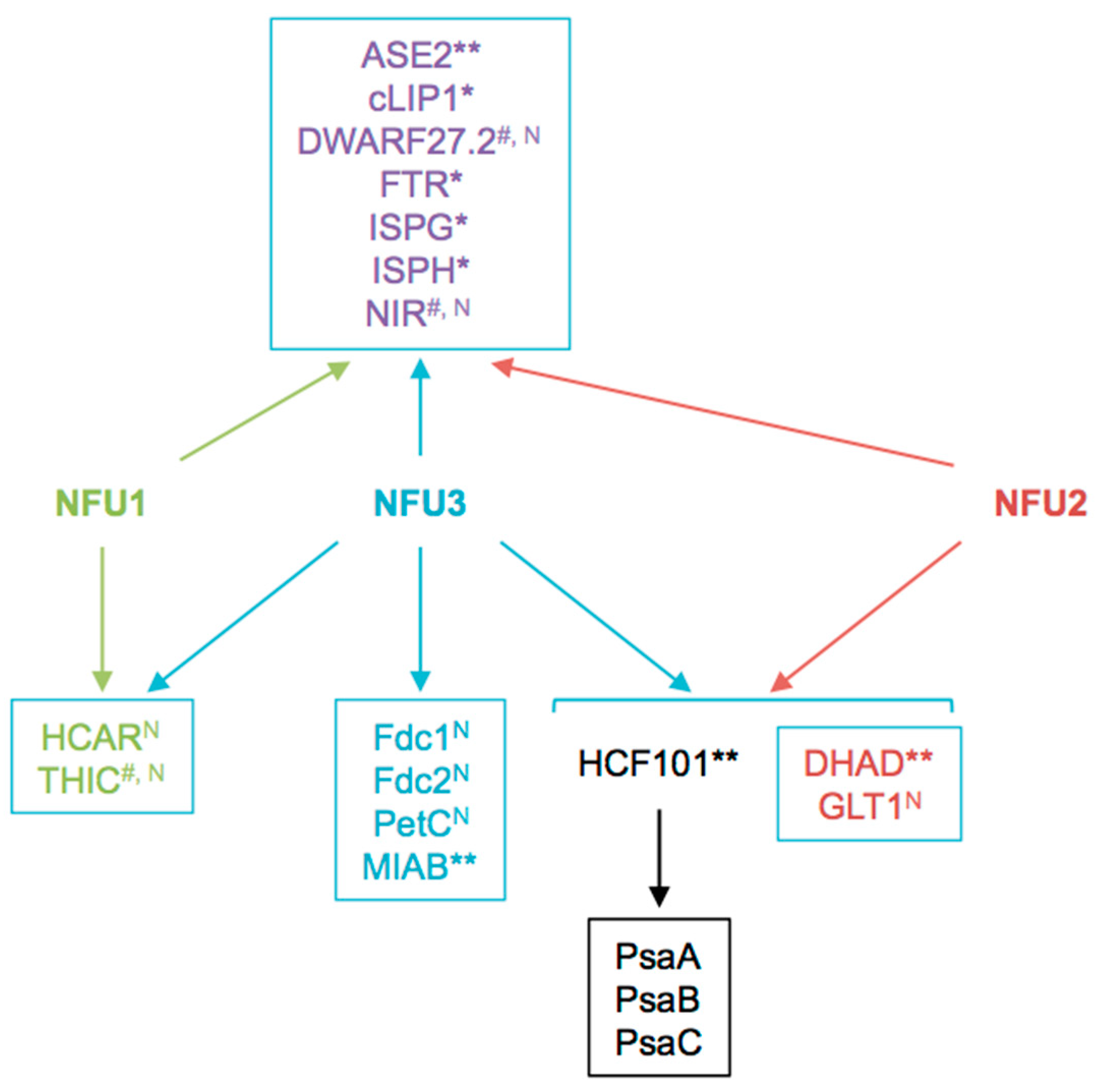
| ID | Acronym | log2 (FC) nfu3-2 Seedlings | log2 (FC) nfu2-1 Seedling | Function | Name |
|---|---|---|---|---|---|
| AtCg00350 | PsaA | −2.08 ** | −1.68 ** | PSI core | Photosystem I subunit A |
| AtCg00340 | PsaB | −1.84 ** | −1.81 ** | PSI core | Photosystem I subunit B |
| AtCg01060 | PsaC | −1.51 * | −2.1 ** | PSI core | Photosystem I subunit C |
| At1g31330 | PsaF | −1.63 ** | −2.05 * | PSI core | Photosystem I subunit F |
| At1g55670 | PsaG | n.v. | −1.58 ** | PSI core | Photosystem I subunit G |
| At3g16140 | PsaH-1 | −1.42 ** | n.d. | PSI core | Photosystem I subunit H-1 |
| At1g52230 | PsaH-2 | n.q. | −2.50 ** | PSI core | Photosystem I subunit H-2 |
| AtCg00510 | PsaI | n.d. | n.d. | PSI core | Photosystem I subunit I |
| AtCg00630 | PsaJ | n.d. | n.q. | PSI core | Photosystem I subunit J |
| At1g30380 | PsaK | n.v. | −1.64 ** | PSI core | Photosystem I subunit K |
| At4g12800 | PsaL | −1.93 ** | −1.77 ** | PSI core | Photosystem I subunit L |
| At1g08380 | Psa0 | n.q. | −1.98 ** | PSI core | Photosystem I subunit O |
| At4g02770 | PsaD-1 | −1.85 ** | n.d. | PSI peripherical | Photosystem I subunit D-1 |
| At1g03130 | PsaD-2 | absent | −1.92 ** | PSI peripherical | Photosystem I subunit D-2 |
| At4g28750 | PsaE-1 | −2.02 ** | −2.01 ** | PSI peripherical | Photosystem I subunit E-1 |
| At2g20260 | PsaE-2 | n.v. | −1.00 ** | PSI peripherical | Photosystem I subunit E-2 |
| At5g64040 | PsaN | −2.26 ** | −2.13 ** | PSI peripherical | Photosystem I subunit N |
| At2g46820 | PsaP | n.v. | n.v. | PSI peripherical | Photosystem I subunit P |
| At3g54890 | Lhca-1 | n.v. | −0.41 * | PSI antenna | Photosystem I light harvesting complex gene 1 |
| At3g61470 | Lhca-2 | n.v. | −1.00 ** | PSI antenna | Photosystem I light harvesting complex gene 2 |
| At1g61520 | Lhca-3 | −1.06 * | −1.13 ** | PSI antenna | Photosystem I light harvesting complex gene 3 |
| At3g47470 | Lhca-4 | n.v. | −0.49 ** | PSI antenna | Photosystem I light harvesting complex gene 4 |
| At1g45474 | Lhca-5 | n.v. | −2.02 * | PSI antenna | Photosystem I light harvesting complex gene 5 |
| At1g19150 | Lhca-6 | n.v. | n.v. | PSI antenna | Photosystem I light harvesting complex gene 6 |
| At2g44860 | PSA2 | n.d. | n.d. | PSI chaperone | Photosystem I assembly 2 |
| At3g55250 | PSA3 | n.v. | n.v. | PSI chaperone | Photosystem I assembly 3 |
| AtCg00360 | Ycf3 | n.q. | +0.27 * | PSI chaperone | Hypothetical chloroplast open reading frame 3 |
| AtCg00520 | Ycf4 | n.v. | n.q. | PSI chaperone | Hypothetical chloroplast open reading frame 4 |
| At1g22700 | PYG7 | n.v. | +0.49 * | PSI chaperone | Pale yellow green 7 |
| At5g44650 | Y3IP1 | n.v. | −0.35 ** | PSI chaperone | YCF3-interacting protein 1 |
| At4g15510 | PPD1 | n.v. | n.v. | PSI chaperone | PsbP domain protein 1 |
| AtCg00020 | PsbA | n.v. | n.v. | PSII reaction center | Photosystem II subunit A |
| AtCg00680 | PsbB | n.v. | n.v. | PSII reaction center | Photosystem II subunit B |
| AtCg00280 | PsbC | +0.37 * | n.v. | PSII reaction center | Photosystem II subunit C |
| AtCg00270 | PsbD | n.v. | n.v. | PSII reaction center | Photosystem II subunit D |
| AtCg00580 | PsbE | n.v. | n.v. | PSII reaction center | Photosystem II subunit E |
| AtCg00570 | PsbF | n.q. | n.d. | PSII reaction center | Photosystem II subunit F |
| AtCg00710 | PsbH | n.v. | n.v. | PSII reaction center | Photosystem II subunit H |
| AtCg00080 | PsbI | n.d. | n.d. | PSII reaction center | Photosystem II subunit I |
| AtCg00550 | PsbJ | n.d. | n.d. | PSII reaction center | Photosystem II subunit J |
| AtCg00070 | PsbK | n.d. | n.d. | PSII reaction center | Photosystem II subunit K |
| AtCg00560 | PsbL | n.d. | n.v. | PSII reaction center | Photosystem II subunit L |
| AtCg00220 | PsbM | n.d. | n.d. | PSII reaction center | Photosystem II subunit M |
| AtCg00700 | PsbN | n.d. | n.d. | PSII reaction center | Photosystem II subunit N |
| AtCg00690 | PsbT | n.d. | n.d. | PSII reaction center | Photosystem II subunit T |
| At2g30570 | PsbW | n.d. | n.d. | PSII reaction center | Photosystem II subunit W |
| At1g44575 | PSII-S | +1.03 ** | +0.73 * | extrinsic | Photosystem II subunit S |
| At1g51400 | PSII-5kD | n.d. | n.d. | extrinsic | Photosystem II-5kDa |
| At3g21055 | PSII-T | n.q. | n.v. | extrinsic | Photosystem II subunit T |
| At3g55330 | PPL1 | +0.35 * | n.v. | extrinsic | Photosystem II subunit P-like 1 |
| At2g39470 | PPL2 | n.v. | n.v. | extrinsic | Photosystem II subunit P-like 2 |
| At1g76450 | PsbP family | n.v. | n.v. | extrinsic | Photosystem II subunit PsbP family |
| At1g69680 | PsbP family | n.d. | n.d. | extrinsic | Photosystem II subunit PsbP family |
| At1g77090 | PsbP family | n.v. | n.v. | extrinsic | Photosystem II subunit PsbP family |
| At5g11450 | PsbP family | −0.67 * | −0.41 * | extrinsic | Photosystem II subunit PsbP family |
| At3g05410 | PsbP family | n.d. | n.d. | extrinsic | Photosystem II subunit PsbP family |
| At3g56650 | PPD6 | +0.69 * | n.v. | extrinsic | PsbB domain protein 6 |
| At5g66570 | PsbO-1 | +0.29 * | n.v. | extrinsic | Photosystem II subunit O-1 |
| At3g50820 | PsbO-2 | +0.31 ** | n.v. | extrinsic | Photosystem II subunit O-2 |
| At1g06680 | PsbP-1 | n.v. | n.v. | extrinsic | Photosystem II subunit P-1 |
| At2g30790 | PsbP-2 | n.d. | n.d. | extrinsic | Photosystem II subunit P-2 |
| At4g21280 | PsQ-1 | +0.44 * | n.v. | extrinsic | Photosystem II subunit Q-1 |
| At4g05180 | PsbQ-2 | n.v. | n.v. | extrinsic | Photosystem II subunit Q-2 |
| At1g79040 | PsbR | n.v. | n.v. | extrinsic | Photosystem II subunit R |
| At2g06520 | PsbX | n.d. | n.d. | extrinsic | Photosystem II subunit X |
| At1g67740 | PsbY-1, 2 | n.d. | n.d. | extrinsic | Photosystem II subunit Y |
| AtCg00300 | PsbZ | n.d. | n.d. | extrinsic | Photosystem II subunit Z |
| At1g29920 | Lhcb1.1 | n.q. | n.d. | PSII antenna | Light harvesting chlorophyll A/B binding protein 1.1 |
| At1g29910 | Lhcb1.2 | n.d. | n.d. | PSII antenna | Light harvesting chlorophyll A/B binding protein 1.2 |
| At1g29930 | Lhcb1.3 | n.v. | n.v. | PSII antenna | Light harvesting chlorophyll A/B binding protein 1.3 |
| At2g34430 | Lhcb1.4 | n.v. | n.v. | PSII antenna | Light harvesting chlorophyll A/B binding protein 1.4 |
| At2g34420 | Lhcb1.5 | n.v. | n.v. | PSII antenna | Light harvesting chlorophyll A/B binding protein 1.5 |
| At2g05100 | Lhcb2.1 | n.q. | n.d. | PSII antenna | Light harvesting chlorophyll A/B binding protein 2.1 |
| At2g05070 | Lhcb2.2 | n.v. | −0.28 * | PSII antenna | Light harvesting chlorophyll A/B binding protein 2.2 |
| At3g27690 | Lhcb2.3 | n.v. | n.d. | PSII antenna | Light harvesting chlorophyll A/B binding protein 2.3 |
| At5g54270 | Lhcb3 | n.v. | n.v. | PSII antenna | Light harvesting chlorophyll A/B binding protein 3 |
| At5g01530 | Lhcb4.1 | n.v. | n.v. | PSII antenna | Light harvesting chlorophyll A/B binding protein 4.1 |
| At3g08940 | Lhcb4.2 | n.v. | n.v. | PSII antenna | Light harvesting chlorophyll A/B binding protein 4.2 |
| At2g40100 | Lhcb4.3 | n.v. | +0.83 * | PSII antenna | Light harvesting chlorophyll A/B binding protein 4.3 |
| At4g10340 | Lhcb5 | n.v. | n.v. | PSII antenna | Light harvesting chlorophyll A/B binding protein 5 |
| At1g15820 | Lhcb6 | n.v. | n.v. | PSII antenna | Light harvesting chlorophyll A/B binding protein 6 |
| ID | Acronym | log2 (FC) in nfu3-2 Seedlings | log2 (FC) in nfu2-1 Seedlings | Fe-S Cluster | Function | Name |
|---|---|---|---|---|---|---|
| At4g04610 | APR1 | n.d. | n.q. | 4Fe4S | Sulfate assimilation | Adenosine 5’-phosphosulfate reductase 1 |
| At1g62180 | APR2 | n.d. | n.q. | 4Fe4S | Sulfate assimilation | Adenosine 5’-phosphosulfate reductase 2 |
| At4g21990 | APR3 | n.d. | n.q. | 4Fe4S | Sulfate assimilation | Adenosine 5’-phosphosulfate reductase 3 |
| At2g16570 | ASE1 | n.d. | n.q. | 4Fe4S | Purine nucleotide biosynthesis | Amidophosphoribosyltransferase 1 |
| At4g34740 | ASE2 | −0.25 * | n.v. | 4Fe4S | Purine nucleotide biosynthesis | Amidophosphoribosyltransferase 2 |
| At4g38880 | ASE3 | n.d. | n.q. | 4Fe4S | Purine nucleotide biosynthesis | Amidophosphoribosyltransferase 3 |
| At1g44446 | CAO | n.q. | n.q. | rieske 2Fe/2S | Chlorophyll biosynthesis | Chloropyll a oxygenase |
| At2g42750 | CDJ1 | n.d. | n.q. | 4Fe4S | Unknown | DNA J protein C77 |
| At5g23240 | CDJ2 | n.d. | n.q. | 4Fe4S | Unknown | DNA J protein C76 |
| At3g05345 | CDJ3 | n.d. | n.q. | 4Fe4S | Unknown | DNA J protein C82 |
| At4g29890 | CMO | n.d. | n.q. | rieske 2Fe/2S | Glycine betaine biosynthesis | Choline monooxygenase (putative) |
| At3g23940 | DHAD | n.v. | n.v. | 2Fe2S | Branched chain amino acid biosynthesis | Dihydroxyacid dehydratase |
| At1g03055 | DWARF27.1 | n.d. | n.q. | 4Fe4S (?) | Strigolactone biosynthesis | DWARF27.1 |
| At1g64680 | DWARF27.2 | −1.05 * | n.q. | 4Fe4S (?) | Unknown | DWARF27.2 |
| At4g01995 | DWARF27.3 | n.d. | n.d. | 4Fe4S (?) | Unknown | DWARF27.3 |
| At1g10960 | FD1 (PETF2) | n.v. | n.q. | 2Fe2S | Electron transport chain | Ferredoxin 1 |
| At1g60950 | FD2 (PETF) | n.v. | n.q. | 2Fe2S | Photosynthesis | Ferredoxin 2 |
| At2g27510 | FD3 | n.q. | n.q. | 2Fe2S | Electron transport chain | Ferredoxin 3 |
| At5g10000 | FD4 | n.d. | n.q. | 2Fe2S | Electron transport chain | Ferredoxin 4 |
| At1g32550 | FdC1 | absent | n.q. | 2Fe2S | Electron transport chain | Ferredoxin like 1 |
| At4g14890 | FdC2 | absent | n.q. | 2Fe2S | Electron transport chain | Ferredoxin like 2 |
| At2g04700 | FTR | n.v. | +0.31 ** | 4Fe4S | Ferredoxin-thioredoxin reductase | Ferredoxin-thioredoxin reductase |
| At1g04620 | HCAR | absent | n.q. | 2x [4Fe4S] | 7-hydroxymethyl chlorophyll a (HMCHL) reductase | 7-hydroxymethyl chlorophyll a (HMCHL) reductase |
| At3g24430 | HCF101 | −0.47 * | n.v. | 4Fe4S | Fe-S cluster transfer | High clorophyll fluorescence 101 |
| At5g04140 | GLU1 | +0.79 ** | +0.83 ** | 3Fe4S | Nitrate assimilation | Glutamate synthase 1 (Fd-GOGAT) |
| At2g41220 | GLU2 | n.v. | n.q. | 3Fe4S | Nitrate assimilation | Glutamate synthase 2 (Fd-GOGAT) |
| At5g53460 | GLT1 | −0.92 ** | −0.60 ** | 3Fe4S | Nitrate assimilation | Glutamate synthase 1 (NADH-dependent) |
| At1g18500 | IPMSI | n.v. | n.v. | 3Fe4S | Leucine biosynthesis | Isopropylmalate synthase |
| At4g13430 | IPMI LSU1 | n.v. | n.v. | 4Fe4S | Leucine biosynthesis | Isopropylmalate isomerase (large subunit 1) |
| At5g60600 | ISPG | n.v. | n.v. | 4Fe4S | Isoprenoid precursor biosynthesis | 4-Hydroxy-2-methylbut-2-enyl diphosphate synthase |
| At4g34350 | ISPH | n.v. | n.v. | 4Fe4S | Isoprenoid precursor biosynthesis | 4-Hydroxy-2-methylbut-2-enyl diphosphate reductase |
| At5g08415 | cLIP1 | n.d. | n.q. | 2x [4Fe4S] | Lipoyl biosynthesis | Lipoyl synthase 1 |
| At4g36390 | MIAB | n.d. | n.q. | 2x [4Fe4S] | t-RNA maturation | Methylthiotransferase |
| AtCg00430 | NDHK | n.v. | n.v. | 4Fe4S | Aerobic respiration | NADH dehydrogenase subunit |
| AtCg01090 | NDHI | n.v. | n.v. | 2x [4Fe4S] | Photosynthesis | NADH dehydrogenase subunit |
| At5g51720 | NEET | n.v. | n.v. | 2Fe2S | Iron homeostasis | NEET |
| At4g01940 | NFU1 | n.v. | n.q. | 4Fe4S | Fe-S cluster transfer | NFU domain protein 1 |
| At5g49940 | NFU2 | n.q. | n.q. | 2Fe2S or 4Fe4S | Fe-S cluster transfer | NFU domain protein 2 |
| At4g25910 | NFU3 | n.d. | n.q. | 2Fe2S or 4Fe4S | Fe-S cluster transfer | NFU domain protein 3 |
| At2g15620 | NIR | −0.45 ** | n.v. | 4Fe4S | Nitrate assimilation | Nitrite reductase |
| At3g44880 | PAO | +1.30 * | −0.25 * | rieske 2Fe/2S | Chlorophyll catabolism | Pheophorbide a oxygenase |
| At4g03280 | PetC | −0.46 * | n.v. | rieske 2Fe/2S | Photosynthesis | Photosynthetic electron transfer C |
| AtCg00350 | PsaA | −2.07 ** | −1.68 ** | 4Fe4S | Photosynthesis | PsaA subunit of photosystem I |
| AtCg00340 | PsaB | −1.84 ** | −1.81 ** | 4Fe4S | Photosynthesis | PsaB subunit of photosystem I |
| AtCg01060 | PsaC | −1.51 * | −2.02 ** | 4Fe4S | Photosynthesis | PsaC subunit of photosystem I |
| At1g71500 | PSB33 | +0.73 * | +0.45 ** | 2Fe2S # | Photosynthesis | Photosystem B protein 33 |
| At4g25650 | PTC52 | +0.34 ** | n.v. | rieske 2Fe/2S | Chlorophyll catabolism | Protochlorophyllide-dependent translocon component 52 |
| At5g04590 | SIR1 | n.v. | n.v. | 4Fe4S | Sulfate assimilation | Sulfite reductase |
| At1g50170 | SIRB | n.q. | n.q. | 4Fe4S | Siroheme biosynthesis | Sirohydrochlorin ferrochelatase B |
| At1g10500 | SUFA1 | n.d. | n.q. | 4Fe4S | Fe-S cluster transfer | SUFA1 |
| At4g04770 | SUFB1 | n.v. | n.q. | 4Fe4S | Fe-S cluster assembly | SUFB1 |
| At5g50210 | SUFE3 | n.d. | n.q. | 4Fe4S | NAD biosynthesis | Sulfur E3 |
| At2g29630 | THIC | absent | n.q. | 4Fe4S | Thiamin biosynthesis | Thiamin C |
| At2g24820 | TIC55 | +0.90 ** | n.v. | rieske 2Fe/2S | Chloroplast Protein Import | Translocon at the inner envelope membrane of chloroplast 55 |
Publisher’s Note: MDPI stays neutral with regard to jurisdictional claims in published maps and institutional affiliations. |
© 2020 by the authors. Licensee MDPI, Basel, Switzerland. This article is an open access article distributed under the terms and conditions of the Creative Commons Attribution (CC BY) license (http://creativecommons.org/licenses/by/4.0/).
Share and Cite
Berger, N.; Vignols, F.; Touraine, B.; Taupin-Broggini, M.; Rofidal, V.; Demolombe, V.; Santoni, V.; Rouhier, N.; Gaymard, F.; Dubos, C. A Global Proteomic Approach Sheds New Light on Potential Iron-Sulfur Client Proteins of the Chloroplastic Maturation Factor NFU3. Int. J. Mol. Sci. 2020, 21, 8121. https://doi.org/10.3390/ijms21218121
Berger N, Vignols F, Touraine B, Taupin-Broggini M, Rofidal V, Demolombe V, Santoni V, Rouhier N, Gaymard F, Dubos C. A Global Proteomic Approach Sheds New Light on Potential Iron-Sulfur Client Proteins of the Chloroplastic Maturation Factor NFU3. International Journal of Molecular Sciences. 2020; 21(21):8121. https://doi.org/10.3390/ijms21218121
Chicago/Turabian StyleBerger, Nathalie, Florence Vignols, Brigitte Touraine, Maël Taupin-Broggini, Valérie Rofidal, Vincent Demolombe, Véronique Santoni, Nicolas Rouhier, Frédéric Gaymard, and Christian Dubos. 2020. "A Global Proteomic Approach Sheds New Light on Potential Iron-Sulfur Client Proteins of the Chloroplastic Maturation Factor NFU3" International Journal of Molecular Sciences 21, no. 21: 8121. https://doi.org/10.3390/ijms21218121
APA StyleBerger, N., Vignols, F., Touraine, B., Taupin-Broggini, M., Rofidal, V., Demolombe, V., Santoni, V., Rouhier, N., Gaymard, F., & Dubos, C. (2020). A Global Proteomic Approach Sheds New Light on Potential Iron-Sulfur Client Proteins of the Chloroplastic Maturation Factor NFU3. International Journal of Molecular Sciences, 21(21), 8121. https://doi.org/10.3390/ijms21218121






